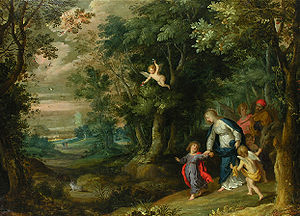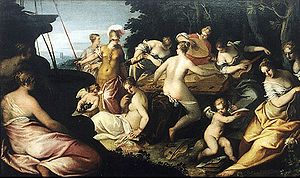
Hans Rottenhammer
Encyclopedia

Biography
He was born in MunichMunich
Munich The city's motto is "" . Before 2006, it was "Weltstadt mit Herz" . Its native name, , is derived from the Old High German Munichen, meaning "by the monks' place". The city's name derives from the monks of the Benedictine order who founded the city; hence the monk depicted on the city's coat...
, where he studied until 1588 under Hans Donauer
Hans Donauer
-Biography:According to Karel van Mander he was the teacher of Hans Rottenhammer.According to the RKD he was also the teacher of the painter Kaspar Amort.-References:* on Artnet...
the Elder. In 1593-4 (and perhaps earlier) he was in Rome
Rome
Rome is the capital of Italy and the country's largest and most populated city and comune, with over 2.7 million residents in . The city is located in the central-western portion of the Italian Peninsula, on the Tiber River within the Lazio region of Italy.Rome's history spans two and a half...
, and he then settled in Venice
Venice
Venice is a city in northern Italy which is renowned for the beauty of its setting, its architecture and its artworks. It is the capital of the Veneto region...
from 1595-6 to 1606, before returning to Germany and settling in Augsburg
Augsburg
Augsburg is a city in the south-west of Bavaria, Germany. It is a university town and home of the Regierungsbezirk Schwaben and the Bezirk Schwaben. Augsburg is an urban district and home to the institutions of the Landkreis Augsburg. It is, as of 2008, the third-largest city in Bavaria with a...
, working also in Munich. He died in Augsburg, apparently in some poverty, and according to some sources an alcoholic.
Work
In Venice he gained a reputation for small highly-finished cabinet paintingCabinet painting
A cabinet painting is a small painting, typically no larger than about two feet in either dimension, but often much smaller. The term is especially used of paintings that show full-length figures at a small scale, as opposed to say a head painted nearly life-size, and that are painted very...
s on copper, of religious and mythological subjects, combining German and Italian elements of style. In particular he combines the landscape tradition of the North with the compositional and figure styles of Tintoretto
Tintoretto
Tintoretto , real name Jacopo Comin, was a Venetian painter and a notable exponent of the Renaissance school. For his phenomenal energy in painting he was termed Il Furioso...
and Veronese
Paolo Veronese
Paolo Veronese was an Italian painter of the Renaissance in Venice, famous for paintings such as The Wedding at Cana and The Feast in the House of Levi...
. He was the first German artist to specialize in cabinet paintings. In Rome he knew the earlier members of the Bamboccianti
Bamboccianti
The Bamboccianti were genre painters active in Rome from about 1625 until the end of the seventeenth century. Most were Dutch and Flemish artists who brought existing traditions of depicting peasant subjects from sixteenth-century Netherlandish art with them to Italy, and generally created small...
, a circle of Northern artists (before the name itself arose), and remained in regular contact with Paul Brill
Paul and Mattheus Brill
Paul and Matthijs Bril were brothers, both born in Antwerp, who were landscape painters who worked in Rome after earning papal favor.-Biography:...
, a Flemish artist living in Rome, sending him plates with the figures painted on for Brill to supply the landscape, according to a dealer's letter of 1617. He also collaborated with Jan Brueghel the Elder
Jan Brueghel the Elder
Jan Brueghel the Elder was a Flemish painter, son of Pieter Bruegel the Elder and father of Jan Brueghel the Younger. Nicknamed "Velvet" Brueghel, "Flower" Brueghel, and "Paradise" Brueghel, of which the latter two were derived from his floral still lifes which were his favored subjects, while the...
in a similar way. He was commissioned in 1600 to paint a Feast of the Gods for Emperor Rudolph II (now Hermitage
Hermitage Museum
The State Hermitage is a museum of art and culture in Saint Petersburg, Russia. One of the largest and oldest museums of the world, it was founded in 1764 by Catherine the Great and has been opened to the public since 1852. Its collections, of which only a small part is on permanent display,...
). A good example of his early style, in which he approaches Tintoretto, is his Death of Adonis in the Louvre
Louvre
The Musée du Louvre – in English, the Louvre Museum or simply the Louvre – is one of the world's largest museums, the most visited art museum in the world and a historic monument. A central landmark of Paris, it is located on the Right Bank of the Seine in the 1st arrondissement...
.
Once back in Germany, he worked on larger altarpieces and decorative schemes for palaces, including the Munich Residenz and Schloss Bückeborg(Goldener Saal), more in the style of Northern Mannerism
Northern Mannerism
Northern Mannerism is the term in European art history for the versions of Mannerism practiced in the visual arts north of the Alps in the 16th and early 17th century...
than his Italian work.

Adam Elsheimer
Adam Elsheimer was a German artist working in Rome who died at only thirty-two, but was very influential in the early 17th century. His relatively few paintings were small scale, nearly all painted on copper plates, of the type often known as cabinet paintings. They include a variety of light...
as an assistant in 1598 or 1599, and no doubt gave Elsheimer an introduction to Bril; when Elsheimer moved on to Rome he and Bril became close friends. Two drawings by Rottenhammer (now in Copenhagen) belonged to Elsheimer, and have an inscription noting they were a gift from Rottenhammer. Elsheimer's mature paintings are all small and on copper, and continue to develop Rottenhammer's synthesis of German and Italian styles, and use of landscape. Among his noted works are those painted for Emperor Rudolph II of Austria: Nativity (1608), Battle Between Centaurs and Lapithæ, and four others, in the Vienna Museum.

